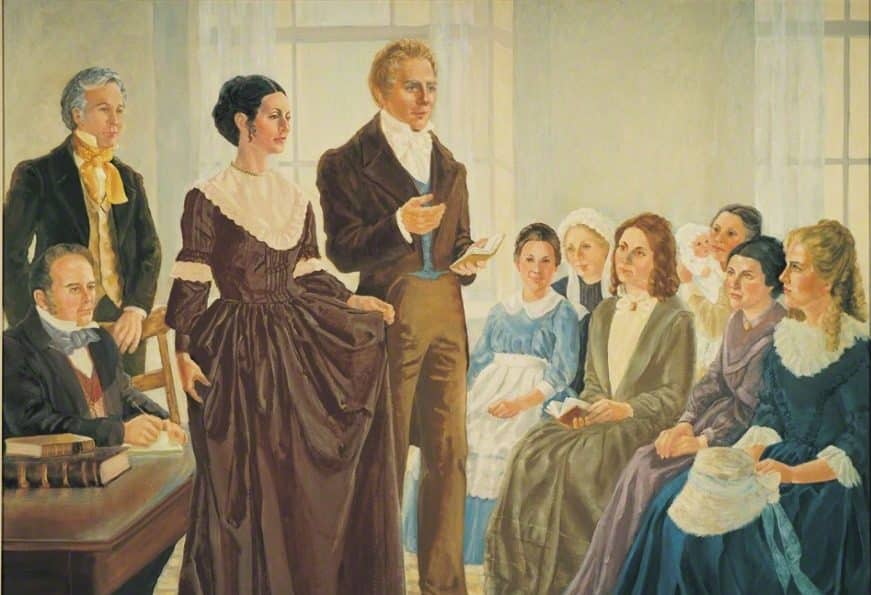vs. Patriarchy, 2
by Eduardo Velasco
Matriarchy: The family and relations between the sexes
Individuals live in large common households, like prehistoric caves or the great houses of the Danubian Culture.
The procreation of large numbers takes precedence, which results in a repellent jumble. Subhuman matriarchy makes females the object of a cult of abomination, deformity, and promiscuity. Children are overpampered and overprotected, to the point of sapping their initiative and entrepreneurial spirit. Nowadays, we see children overloaded with coats, scarves, jumpers, gloves, and hats, even when it is clearly not cold at all. Mothers repress them when they show initiative or independence, an entrepreneurial spirit, or when they take risks.
As promiscuity is often such that no one knows who the fathers are, the family name is passed down through the mother’s side. Even in cases where there is marriage, the man often takes the woman’s surname and goes to live in the woman’s house, as was once the case among the Basques.
Families are not solid or defined. There are incestuous and endogamous tendencies. The environment encourages pederasty and rape, as in so many primitive societies today. Because of these practices, the deformed and defective abound.
Matriarchy is no friend of hierarchies, and everything tends to blur in the presence of the collective totem and the mass.
Patriarchy: the family and relations between the sexes
Individuals live in single-family homes.
Despite the importance of fertility and birth rate, the number of children is not important, but the quality of each child. This favours the emergence of strong families, eugenic selection systems and careful training and education methods. ‘Maybe few, but very good’, is the emblematic phrase of this mentality. In patriarchy, sons are treated as men from the time they are boys, while in matriarchy they are still pampered and treated as boys when they are still adults. Fathers and clan veterans seek ways of ‘manning up’ their sons through hardening initiations, and mothers have no say in this, for it is taken for granted that after a certain age (in Sparta and medieval European aristocracies, at age seven), the boy must be emancipated from female influence. Boys are allowed to run around, get hurt, get dirty and unclothed to grow up healthy and tough. Boys are encouraged to develop curiosity, fascination and respect for violence. It is especially in the ancient Aryan armies that the mentality of sacrifice, training, ceremony, fighting and dedication reaches its peak.
The ritual and solemn marriage ceremony is a patriarchal institution. The strong family, the clan, and the tightly knit community are patriarchal phenomena to the core. The wife takes her husband’s surname when she marries, and the children will have the father’s surname. There is a tendency for children to acquire the surname ‘son of’ about their paternity. This is evident in Anglo-Saxon and Scandinavian countries, with the adoption of surnames ending in –son or –sen, in Slavic countries with –vich or –witz, or in Spain itself, with the suffixes –ez.
With matriarchy one knows exclusively who the mother is. With patriarchy, the father and mother are known, and the cleanliness of the lineage is guaranteed as long as the patriarchal law is respected. The patricians formed the aristocracy of Rome. Patriarchy guarantees the purity of blood. Matriarchy guarantees its interbreeding. Deeply united families emerge and practically create their tradition and mythology, even in terms of divine ancestry. Pride in the lineage of the fathers, the zeal for purity of blood, and the desire to preserve the race—racism—flourishes. Loyalty, honour and restraint, i.e. the instinct of protection of the pure and spiritual essence, take root. The Aryan patriarchy is the only social system which considers that honour also has to do with women.
Patriarchy tends to form severe hierarchies and caste systems which are separated by genetic criteria, and which favour the distinction of the best elements and the concentration of power in their hands. Examples are the systems of socio-racial separation that arose in India, Iran, Greece, Rome and the feudal Middle Ages. Apartheid in South Africa and Rhodesia is a more modern example.

2 replies on “Matriarchy”
For the first instalment of this series see here.
Another thing about patriarchy is that men have to earn the right to marry women. Anyone who is weak both physically and mentally were weeded out.
One modern misconception about eugenics is that it is purely about genetics. Eugenics took both genetic and environmental factors into account. That is why back then some Whites would be sterilized even if they were of “Aryan” blood. This system and cultural aspect of the West made sure that White people lived virtuous and productive lives with no room for aloof laziness or self-gratification. When eugenics stopped being the guiding source for White youths that is when degeneracy Whites practice today finally took off.